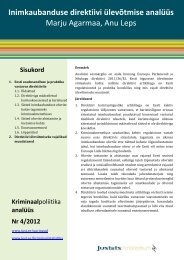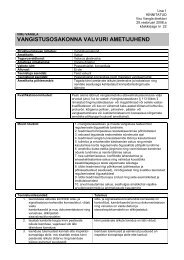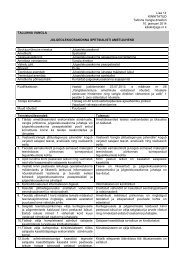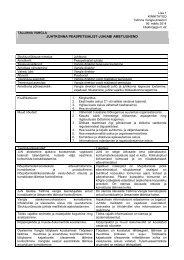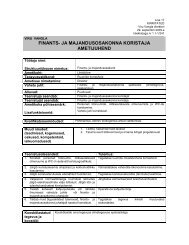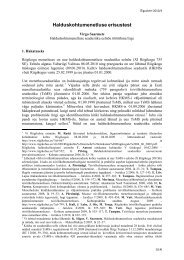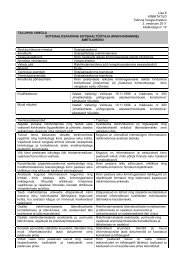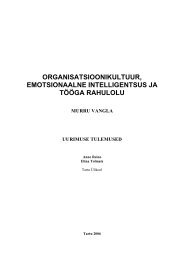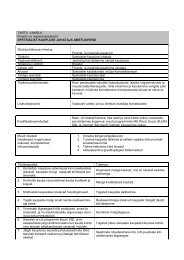11. Retsidiivsus Eestis - Justiitsministeerium
11. Retsidiivsus Eestis - Justiitsministeerium
11. Retsidiivsus Eestis - Justiitsministeerium
Create successful ePaper yourself
Turn your PDF publications into a flip-book with our unique Google optimized e-Paper software.
RETSIDIIVSUS EESTIS 2010<br />
1. RECIDIVISM IN ESTONIA – SUMMARY<br />
RETSIDIIVSUS EESTIS 2010<br />
on. Bodies conducting proceedings who themselves had participated in relevant<br />
hearings found that due to big workload the judges do not have sufficient<br />
time to get to know a person or a person’s situation, wherefore decisions are<br />
largely made on the basis of materials submitted by a prison.<br />
Making a decision on a person’s premature release, the bodies conducting<br />
proceedings assess upon evaluating the recidivism risk that the consideration<br />
of the following factors is most important – whether they deal with an addict,<br />
whether and to which extent the person has been previously punished and<br />
whether the person has an opportunity to start work after release.<br />
Prisoner’s behaviour in prison is observed in the context of premature release<br />
primarily on the basis of existing violations of discipline and their nature –<br />
serious violations of discipline substantially hinder a person’s possibilities for<br />
release. It is essential for judges and prosecutors to also consider whether a<br />
prisoner worked or studied during imprisonment. The need to consider these<br />
factors important was confirmed by a section of this study that deals with<br />
former prisoners’ ability to cope in which it was found that people who had<br />
worked during imprisonment found work considerably easier after release. It<br />
was also found that the prisoner’s low level of education prevents them to find<br />
work after release, wherefore acquiring education during prison sentence is<br />
important.<br />
1.3. Recidivism of convicted offenders<br />
Recidivism indicators of convicted offenders reflect the commission of new<br />
criminal offences by these people whom the court did not impose actual<br />
punishment, i.e. these people have been taken into consideration who had<br />
the possibility to commit new criminal offences outside at large. The 2007<br />
recidivism rate of 24% shows that every fourth convicted offender was interrogated<br />
as a suspect in a new criminal offence within a year after a court<br />
judgement. As the data on convicted offenders actually start with year 2007,<br />
it is not possible to make more comprehensive comparisons, the 2008 data on<br />
convicted offenders do not show any changes in the recidivism rate.<br />
Within first three months after a court judgement, a new criminal offence<br />
is committed by 8% of people, 14% within first six months and 30% within a<br />
year and a half.<br />
By types of procedure the annual recidivism rate varied between 21% and<br />
28%, it was the highest in case of expedited procedure and the lowest in case<br />
of criminal matters adjudicated by way of settlement procedure. A type of<br />
procedure by itself does not increase or decrease recidivism; instead it can be<br />
influenced, for example, by the structure of criminal offences and understandable<br />
punishments. For example, this can be behind higher recidivism rate of<br />
expedited procedure that compared to other types of procedure, more thefts<br />
and people who have driven a vehicle in a state of intoxication come before the<br />
court in expedited procedure, in which case we are dealing with people who<br />
have often repeatedly committed criminal offences and in case of whom the<br />
corresponding risk is continuing.<br />
There were also differences with respect to recidivism of convicted offenders<br />
by courts. The proportion of people who had repeatedly committed criminal<br />
offences was the lowest in criminal matters of the Tartu County Court where<br />
20% of people convicted in 2007 committed a new criminal offence; in the<br />
Viru County Court the proportion of repeated offenders was the highest –<br />
28%.<br />
It came out from the poll conducted among prosecutors and judges that the<br />
recidivism risk is taken into consideration in case of court judgements primarily<br />
when the type of principal punishment is considered (pecuniary punishment<br />
or imprisonment) and whether it is possible to conditionally release<br />
a convicted offender. Bodies conducting proceedings regarded the term of<br />
punishment and supplementary punishments less important.<br />
A fact that there was a considerable number of those who think that the<br />
court underestimates the recidivism risk of the accused when choosing the<br />
type of punishment refers to a certain discrepancy between recidivism indicators<br />
and the opinions of bodies conducting proceedings. It is difficult to<br />
find any basis to such estimate from recidivism indicators, as the recidivism<br />
rate of people punished with actual imprisonment exceeds nearly twice the<br />
recidivism rate related to other punishments. Also, the recidivism rate is quite<br />
similar in case of convicted offenders and those people with regard to whom<br />
proceedings were terminated due to reasons of expediency. Such results still<br />
refer more to an optimal evaluation of the recidivism risk both by prosecutors<br />
and judges.<br />
Upon evaluating the recidivism risk in a situation when the imposition of<br />
actual prison sentence is considered, the bodies conducting proceedings regard<br />
the consideration of prior punishment especially important. Paying attention<br />
to this indicator is justified both by the results of this study and the studies of<br />
other countries – the more times a person has been punished, the higher the<br />
risk of committing new criminal offences.<br />
1.4. Recidivism upon termination of proceedings for reasons of<br />
expediency<br />
Prosecutor’s Office does not send all people who are being suspected of<br />
commission of criminal offences to the court. In case of less serious criminal<br />
offences and under some other conditions, the Prosecutor’s Office has<br />
162<br />
163



